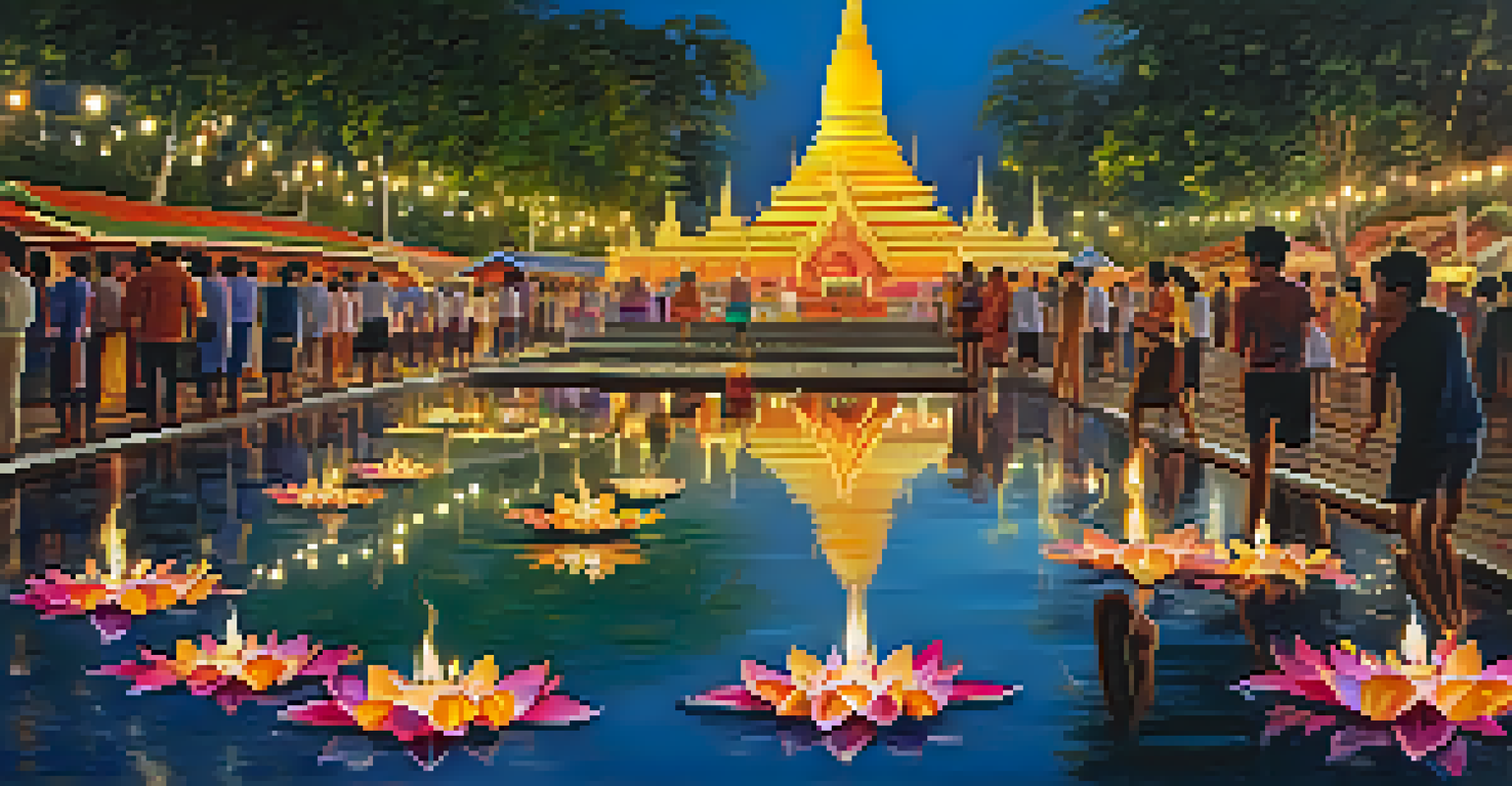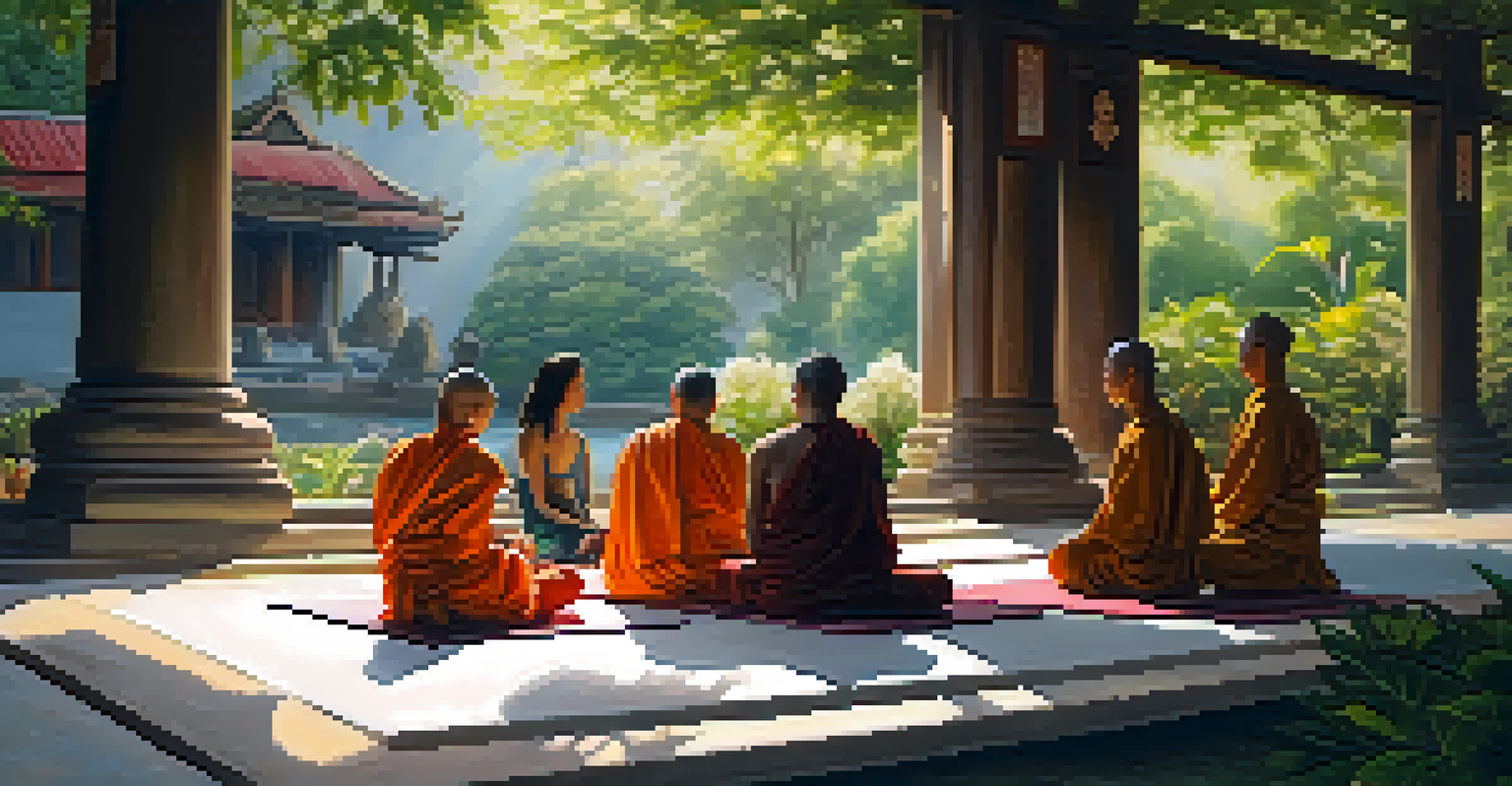How Buddhist Temples Attract Tourists in Thailand's Culture

The Spiritual Allure of Thai Buddhist Temples
Buddhist temples in Thailand are more than just beautiful structures; they are spiritual sanctuaries that attract millions of tourists every year. The serene atmosphere, detailed architecture, and vibrant colors create an inviting environment that encourages reflection and peace. Visitors often find themselves captivated by the rich history and deep-rooted cultural significance these temples embody.
The beauty of the world lies in the diversity of its people.
Moreover, the spiritual practices and rituals performed at these temples provide a unique glimpse into Thai culture. Tourists are drawn to ceremonies such as monk ordinations and merit-making, allowing them to participate in local traditions. This immersive experience not only enriches their understanding of Buddhism but also fosters a sense of connection with the local community.
As tourists explore these sacred spaces, they often leave with a profound appreciation for the values of mindfulness and compassion that Buddhism promotes. In this way, Thai temples serve as a bridge between cultures, inviting visitors to experience spiritual growth while appreciating the beauty of Thailand's heritage.
Architectural Wonders: A Feast for the Eyes
The architectural beauty of Thai Buddhist temples, or 'wats,' is a major draw for tourists. Each temple boasts intricate designs, from the towering chedis to the ornate murals depicting Buddhist stories. This artistic expression not only serves a religious purpose but also showcases Thailand's rich artistic traditions, making it a visual feast for visitors.

Take, for instance, Wat Phra Kaew in Bangkok, which is adorned with dazzling mosaics and a stunning Emerald Buddha. Tourists flock to see these masterpieces, often snapping photos to capture the moment. The architectural diversity found in temples across Thailand, from the golden spires of Wat Arun to the tranquil gardens of Wat Pho, offers something for everyone to enjoy.
Temples as Spiritual Sanctuaries
Thai Buddhist temples offer a unique blend of spiritual practices and cultural experiences that deeply engage visitors.
As they wander through these stunning spaces, tourists often feel transported to another world, one filled with beauty and tranquility. The visual impact of these temples creates lasting memories and encourages visitors to learn more about Thai culture and its artistic heritage.
Cultural Festivals: A Vibrant Showcase of Tradition
Thai Buddhist temples are often the heart of cultural festivals, attracting tourists eager to witness traditional celebrations. Events such as Loy Krathong and Songkran not only highlight religious significance but also provide a lively atmosphere filled with music, dance, and food. Tourists are drawn to the vibrant colors and joyous spirit of these festivals, making them a memorable part of their travel experience.
Travel is the only thing you buy that makes you richer.
During these festivals, temples become gathering places where locals and visitors come together to celebrate. Tourists can engage in traditional practices, such as floating krathongs or participating in water fights, which fosters a sense of camaraderie and cultural exchange. This interaction allows visitors to experience Thai culture firsthand and gain a deeper appreciation for its customs.
Festivals held at Buddhist temples create a dynamic atmosphere that resonates with tourists. The blend of spirituality, community, and celebration offers a unique insight into Thai culture, attracting those seeking authentic experiences and enriching their travel adventures.
Educational Opportunities: Learning About Buddhism
Many tourists visit Buddhist temples in Thailand with a desire to learn more about Buddhism and its teachings. Temples often offer guided tours and informative sessions led by monks or knowledgeable staff, providing insights into the philosophy and practices of Buddhism. This educational aspect can be a transformative experience for visitors, deepening their understanding of a religion that emphasizes compassion and mindfulness.
For instance, some temples host meditation retreats where tourists can practice mindfulness techniques alongside local practitioners. These retreats not only offer a chance to unwind but also allow participants to explore their inner selves in a supportive environment. The opportunity to learn directly from monks adds authenticity to the experience, making it memorable.
Architectural Beauty Captivates Tourists
The intricate designs and artistic expressions found in Thai temples create a visual feast that draws tourists from around the world.
By engaging in educational experiences at these temples, tourists often leave with a wealth of knowledge and a newfound appreciation for the teachings of Buddhism. This thirst for learning not only enriches their travels but also fosters a greater understanding of cultural diversity and spiritual practices.
The Role of Community: Connecting Locals and Visitors
Buddhist temples often serve as community centers, where locals and tourists intersect, creating a unique social dynamic. Many temples welcome visitors not just as tourists but as participants in the community, encouraging interactions that enrich the travel experience. This connection fosters mutual respect and understanding, allowing both locals and visitors to share their stories and experiences.
Events such as merit-making ceremonies or community outreach programs invite tourists to contribute positively to the temple and its surrounding community. By participating in these activities, tourists gain a sense of belonging and contribute to the cultural tapestry of Thailand. This shared experience helps break down barriers and builds lasting relationships.
As visitors engage with the local community, they often leave with a sense of fulfillment that goes beyond typical tourism. The bonds formed through shared experiences at temples can lead to friendships and cultural exchanges that last long after the trip has ended.
Photography and Social Media: Capturing Memories
With their stunning architecture and serene landscapes, Thai Buddhist temples are a photographer's dream. Tourists are often seen capturing the beauty of these sites, creating Instagram-worthy moments that showcase the allure of Thailand's rich culture. The visual appeal of these temples not only attracts visitors but also encourages them to share their experiences online, boosting tourism.
Social media plays a significant role in promoting these temples, as stunning images can inspire others to visit. Travelers often rely on platforms like Instagram and Pinterest to discover hidden gems or learn about the history behind famous temples. This digital sharing creates a ripple effect, drawing even more tourists to explore Thailand's sacred spaces.
Community Engagement Enhances Travel
Visitors to Buddhist temples often participate in community events, fostering connections that enrich their travel experience and cultural understanding.
As tourists share their experiences, they contribute to a growing online community that celebrates Thai culture. These shared memories not only highlight the beauty of the temples but also foster a sense of connection among travelers, encouraging them to explore and learn more about this vibrant culture.
Sustainable Tourism: Protecting Cultural Heritage
As tourism increases, the need for sustainable practices becomes more urgent, especially in culturally rich areas like Thailand. Buddhist temples are often at the forefront of these efforts, promoting responsible tourism that respects local traditions and the environment. Many temples educate visitors on how to be mindful of their impact while enjoying their cultural experiences.
Initiatives such as limiting visitor numbers, encouraging donations for temple maintenance, and promoting eco-friendly practices help preserve these sacred spaces for future generations. Tourists are encouraged to engage in respectful behaviors, such as dressing modestly and participating in temple etiquette, which fosters a sense of responsibility.

By supporting sustainable tourism practices, visitors can enjoy the beauty of Thai temples while contributing to the preservation of cultural heritage. This approach not only enhances the travel experience but also ensures that future generations can appreciate the spiritual and artistic treasures that Thailand has to offer.